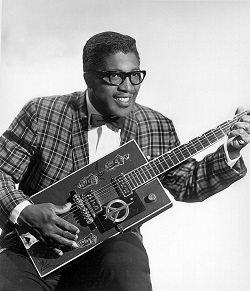How
are you?
This
week's lecture is “1950s”, the 4th topic of “Blues”, which is a summary of the contents of “113.
Blues: 4. 1950s” introduced on November 29th (Wed),
2017.
The transition from country blues to urban blues, which began in the 1920s, was driven by a series of economic crises and booms, which caused many rural blacks to migrate to urban areas, known as the “Great Migration”. The long boom after World War II led to another large-scale migration of African-Americans, the “Second Great Migration,” which resulted in significant increases in the real income of the urban blacks and new migrants constituted a new market for the music industry.
The term “race record” was originally used by the music
industry for African-American music, but was later replaced by the term “rhythm
and blues”, and the rapidly evolving music market reflected in Billboard
magazine's Rhythm and Blues chart. This marketing strategy reinforced trends in
urban blues music, such as the use of electric instruments and amplification,
and the generalization of blues beat and blues shuffle, which were found
everywhere in rhythm and blues. This commercial flow also had a significant
impact on blues music, which, along with jazz and gospel music, became a component
of rhythm and blues.
 |
| The cover of race records catalogue of Victor Talking Machine Company |
After
World War II, new styles of electric blues became popular in cities such as
Chicago, Memphis, Detroit and St. Louis. Electric blues was played through a
microphone and PA system or overdriven guitar amplifier using electric guitars,
double bass (later replaced by bass guitars), drums and harmonica. From 1948,
when Muddy Waters recorded his first success "I Can't Be Satisfied",
Chicago became a center for electric blues. Chicago blues was heavily
influenced by Delta blues, as many of the performers had migrated from the
Mississippi area.
 |
| Muddy Waters |
In
the 1950s, blues had a major impact on mainstream American popular music.
Popular musicians such as Bo Diddley and Chuck Berry were influenced by the
Chicago blues, but their passionate playing styles helped break the prejudice
that blues is melancholic.
 |
| Bo Diddley |
 |
| Chuck Berry |
In
the late 1950s, a new style of blues pioneered by Magic Sam, Buddy Guy and Otis
Rush appeared in Chicago's West Side. This "West Side sound" was
supported by powerful rhythm parts from rhythm guitar, bass guitar and drums,
and an amplified electric lead guitar dominated the sound, and the expressive
guitar solo was a key feature of the music.
 |
| Buddy Guy |
Around
the late 1950s, a genre called “Swamp Blues” developed near Baton Rouge.
Strongly influenced by Jimmy Reed, swamp blues was characterized by a slower
pace and simpler harmonica use than the Chicago Blues style.
 |
| Jimmy Reed |
Thank
you.





No comments:
Post a Comment